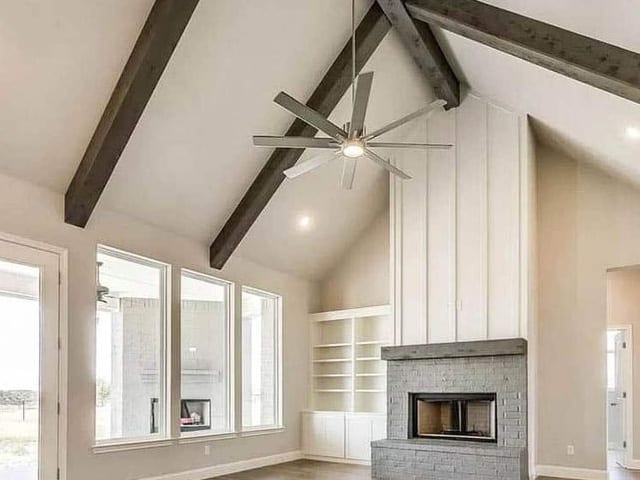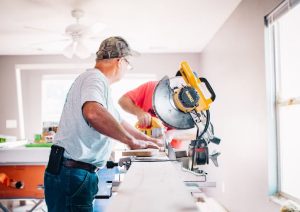With a change in new home designs, more people are moving away from square-cornered, flat, and sloped ceilings to vaulted ceilings.
Nowadays, modern architectural designs can choose from vaulted and sloped ceilings, and more people choose vaulted ceilings to give a modern touch to their homes.
If you are looking for the installation of an insulated ceiling for your home, you might explore options of the cheapest way to insulate a vaulted ceiling.
As the popularity of vaulted ceilings increases, construction and home improvement companies have come up with various options to insulate a vaulted ceiling.
However, not every type of insulation for a vaulted ceiling is cheap, and one has to explore options when choosing the cheapest way to insulate a vaulted ceiling.
This article explores the types of insulation you can use on your vaulted ceiling and the cheapest way to insulate a vaulted ceiling. Read on to know more about the insulation of these modern-design ceilings.

What is the Cheapest Way to Insulate a Vaulted Ceiling?
A vaulted ceiling is a self-supporting ceiling with an arch that extends from the side walls to the center. Because of its design, this ceiling gives the illusion of greater overhead space.
Vaulted ceilings can be insulated in several ways, but the cheapest and the most affordable way to insulate a vaulted ceiling is to use fiberglass batts.
Stapling the batts to the lower part of the ceiling is required when insulating fiberglass insulation. Since fiberglass is pliable, soft, and easy to cut, it can be fitted in every roof corner to give proper insulation against heat and cold.
Some other advantages of using fiberglass batts for insulating a vaulted ceiling include fast installation, minimal dust accumulation during installation, and consistent quality, as these fiberglass batts are made up of resilient fibers which are easy to cut and mold.
It is advisable to consider the fiberglass’s R-value (resistance value) before proceeding to install it, as it can affect the cost of the fiberglass batt material.
The R-value of the insulating material shows the resistance against heat, cold, and moisture. A material with a higher R-value is likely to last longer, have greater resistance, and provide protection against cold, heat, and condensation for a longer period of time.
Types of Ceiling Insulation
Now that we know the cheapest way to insulate a vaulted ceiling, let us look at other common types of insulation used in the vaulted ceiling. The different types of insulation for vaulted ceilings are:
Spray Foam Insulation
Spray foam insulation is a type of insulation that uses soft water-blown foam to deliver a highly effective insulation barrier against heat and cold. The most commonly used spray foam for insulation is Icynene spray foam.
The Icynene spray foam expands and fills holes created between a ceiling’s joists and rim joists. By stopping heat from filtering out, Icynene forms an air barrier between the ceiling and joists while minimizing moisture and condensation build-up.
Unlike loose-fill ceiling insulation, spray foam insulation does not sag over time. Instead, it ensures constant and sustained insulation for the ceiling for a long time.
Loose-fill Insulation
This type of insulation involves small particles made of cellulose, fiberglass, rock, wool, and other material to insulate a vaulted ceiling. The small particles are blown into the spaces between the joists to provide full insulation against heat, cold, and moisture.
However, unlike spray foam insulation, loose-fill insulation does not fill holes in your vaulted ceiling, which means that air will be able to pass between gaps in joists, causing a loss of energy and heat. Plus, loose-fill insulation can get moulded if moisture reaches it and is prone to shifting to one side due to airflow.
To prevent moisture from spoiling the vaulted ceiling installation, you might need to install soffit vents alongside loose-fill insulation, increasing the installation cost.
Structural Insulated Panel
Made of insulating foam between two structural facings, SIPs are an effective method to insulate a vaulted ceiling;. However, SIPs do not offer the same level of potential energy saving as spray foam insulation, it still provides energy savings of up to 12% and has good R-values and sound-proof qualities.
However, it is a common complaint that insects and rodents may get inside SIPs, which can be combatted by using insecticides inside the panel. In addition, SIPs need to be combined with ventilation systems which might result in additional costs.
Most Cost-Effective Ways to Insulate a Vaulted Ceiling
Insulating a vaulted ceiling may seem an arduous and hard task to you. However, due to the many options available, it is easier than ever to insulate a vaulted ceiling.
It must be noted that not all methods of insulating a ceiling are cheap and affordable. The following best practices ensure that your vaulted ceilings are insulated properly and easily.
Consider the Roof Space and Region
Insulation needs to be done after considering the height of the vaulted ceiling. Most of the time, people do not take care of the height of the ceiling, which results in a low ceiling that gives a crowded and cramped look to the room.
When considering the thickness of the insulation, you need to consider certain requirements based on the region where your home is located. The factor of the home region needs to be considered, regardless of the material you are using for insulation of your vaulted ceiling, whether it is spray foam, structural insulation, or fiberglass insulation. Cold regions such as the northern areas require insulation with an R-value of more than R-40 to R-60.
Consider Moisture Problem
The most pressing issues for homeowners and constructors are heat and moisture control when choosing material for insulation of vaulted ceilings. If the right type of insulating material is not used, the freezing air and heat will easily enter your roof and into your home, causing the roof to leak. Due to this leakage, mold or rot can take over your roof insulation, posing a bioburden you with repair and renovation costs. In this problem, many homeowners leave air space between the roof deck and install air vents to prevent moisture.
Install the Roof Insulation Properly
Installation of roof insulation is an extremely important step that contractors must consider when insulating a vaulted ceiling. Most contractors use batt insulation to insulate a vaulted ceiling and install them on top of the ceiling rafters. It is preferable to leave a space of at least 2 inches between the roof cover and insulation material in order to allow for more ventilation.
Before insulation, ensure each piece of the insulation and cut them according to the width of the rafters. When pressing the fiberglass batts, ensure not to stuff them into the place so as not to cause dense compression. In case of stuffing and cramming, the R-value of insulation might drop.
Save money on insulation by cutting around the electrical and light sockets and save the extra scrap insulation by trimming it to fit the gaps and small crevices.
Make Safety a Priority
Wearing proper gear is essential when installing roof insulation on a vaulted ceiling. Make use of protective gloves, and long sleeves as well as pants and a ventilator mask. Also, always wear a protective helmet when doing structural work, such as adjusting joists. This precaution is needed, particularly if you are installing fiberglass ceiling insulation.
Consider your choices
When installing insulation for your vaulted ceiling, it is imperative to consider and weigh all your choices. Since a vaulted ceiling design differs from a flat or a sloped ceiling, which has a narrower space than a vaulted ceiling, it must be installed properly and carefully.
To lower and save costs on the insulation of vaulted ceilings, use thinner batts with a higher insulating factor and a suitable material for a vaulted ceiling, such as cellulose or fiberglass. If you intend to cover all areas of the roof, spray foam insulation is advisable to reach narrow areas of the roof.
Consider your choices for roof insulation, keeping in mind the following factors: warm air flow, heat, moisture repelling, and the longevity of the material you intend to use for insulation of your vaulted ceiling.
Install Batt Insulation Carefully
Most vaulted ceilings require batts for optimum installation, which are costlier. However, batts let air flow through them if they settle over time or are not installed properly. Moreover, the elaborate designs on the roof are harder to insulate as they contain more elements through which air can leak. In addition, light fixtures and electrical wires running through the roof peak to the walls add to the complications of the insulation process. This is why it is important to consider the material of the batts as well as the insulation before choosing the insulation for a vaulted ceiling.
Steps to Insulate a Vaulted Ceiling by Using Fiberglass Batts
Here are the steps to insulate a vaulted ceiling by using fiberglass batts:
Step 1
Measure the distance between the rafters and roof trusses and multiply the number of spaces by the length of the trusses. Doing so will give you an idea of how much insulation is required.
Step 2
Check the R-value of the insulation, which will fit between the trusses against government-approved ratings to save time and cost.
Step 3
Roll out the insulation and cut it into pieces for easy installation. Be sure to press the pieces gently into position without cramming them.
Step 4
Staple the flanges of insulation to the trusses bottom, making sure to keep the insulation tight
Step 5
Cut the insulation around the light sockets and electrical outlets. You may also use scrap insulation to fill in any gaps and leftover spaces.
Step 6
Secure the gaps between the insulation with wire supports that fit perpendicular to the trusses
Step 7
Be sure to wear protective gloves and goggles during insulation. If you are working with fiberglass, cover your mouth and nose. It is important to wear a helmet when installing roof insulation on a vaulted ceiling and use a ladder with an appropriate height. These precaution measures can prevent injuries on exposed nails and other problems.
Conclusion
Insulating a vaulted ceiling is an essential part of the home improvement and renovation process. Although various insulation materials are available in the market, not all are cheap and come with additional costs. This is why homeowners and contractors want to know the cheapest way to insulate a vaulted ceiling. The most affordable and cheap way to insulate a vaulted ceiling is by using fiberglass batts, which are easier to install and are affordable and long-lasting insulation materials.



